Options
Basic channels
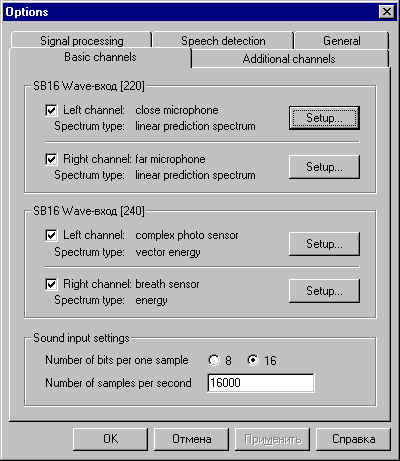 Use "Basic Channels" property sheet to configure
the usage of multi-sensor setup with your sound card(s). Pressing Setup... button
for each channel, you can select the channel type (close microphone, far microphone,
simple photo sensor, complex photo sensor (reserved for future usage) and breath sensor.
Use "Basic Channels" property sheet to configure
the usage of multi-sensor setup with your sound card(s). Pressing Setup... button
for each channel, you can select the channel type (close microphone, far microphone,
simple photo sensor, complex photo sensor (reserved for future usage) and breath sensor.
You can also select the spectrum type for each channel and change the recording
volume. We recommend to use linear prediction spectrum for microphones and energy
for other channels.
Additional channels
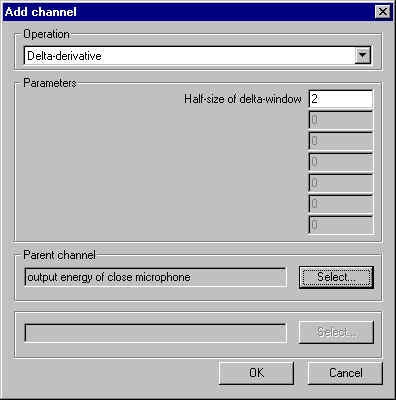 Use "Additional Channels"
property sheet to add special user-defined spectral channels. Pressing the Add
button You can add another channel to the list f additional channels. Remove
button removes one of the selected channels (if it does not have child channels). Remove
All button rmoves all channels from additional channels list. Properties
button opens the Channel Properties dialog box where You can change different parameters
of selected channel. Finally, the Add to Result button allows You
to add this channels to the Resulting spectrum channel components list.
Use "Additional Channels"
property sheet to add special user-defined spectral channels. Pressing the Add
button You can add another channel to the list f additional channels. Remove
button removes one of the selected channels (if it does not have child channels). Remove
All button rmoves all channels from additional channels list. Properties
button opens the Channel Properties dialog box where You can change different parameters
of selected channel. Finally, the Add to Result button allows You
to add this channels to the Resulting spectrum channel components list.
Resulting spectrum channel components list is located below the Additional
channels list. You can modify it by adding or removing channels. You can add
wheather basic channels or Additional channels to the Resulting spectrum channel
components list.
 When You press Add buton to add additional channels,
the Aadd channel dialog box appears. To add new channel, You have to select one of
the spectral operations from the Operations list, modify or set the operations parameters
and select one (for unary operations) or two (for binary operations) parent spectral
channels.
When You press Add buton to add additional channels,
the Aadd channel dialog box appears. To add new channel, You have to select one of
the spectral operations from the Operations list, modify or set the operations parameters
and select one (for unary operations) or two (for binary operations) parent spectral
channels.
Here is the complete list of spectral operations with their short description:
| Operation name |
Operation type |
Short description |
Parameters |
| log10 |
unary |
log10() of parent channel |
not used |
| Absolute value |
unary |
Absolute value of parent channel |
not used |
| Change sign |
unary |
parent = - child |
not used |
| Delta-derivative |
unary |
delta-derivative of parent channel |
derivative frame size / 2 |
| Mel-frequency scaling |
unary |
Mel-frequency scaled parent channel |
minimal cut-off frequency (Hz), maximal cut-off frequency
(Hz)
total number of triangular filters, number of linerly-scaled filters,
frequency of last linear filter (Hz) |
| Time-axis smoothing |
unary |
Time-axis smoothing of parent channel |
Type of smoothing (rectangular, triangular or exponential)
and smoothing frame size
|
| Freequency-axis smoothing |
unary |
Freequency-axis smoothing of parent channel |
Type of smoothing (rectangular, triangular or exponential)
and smoothing frame size |
| Maximal value of all parameters |
unary |
Maximal value of all parameters in parent channel |
not used |
| Norm of parameters vector |
unary |
Norm of vector of parameters of parent channel |
type of norm (L1, L2 etc.) |
| Normalization |
unary |
child = (parent - offset) / factor |
offset, factor |
| Normalizationusing Mean and Standart Deviation values |
unary |
Normalization of parent channel using Mean and Standart
Deviation values: child = (parent - Mean) / stdDev |
not used |
| Threshold bounding |
unary |
Threshold bounding of parent channel |
threshold type (upper or lower), threshold itself |
| Parameter with maximal |derivative| |
unary |
Parameter of parent channel with maximal |derivative| |
frame size / 2 for delta-derivative calculation, derivative
threshold |
| Speech detection |
unary |
Speech detection in parent channel |
See Speech detection |
| Subset of parameters |
unary |
Subset of parameters in parent channel parameters vector |
Indeces of starting and of ending parameters |
| Parameter's reliability |
binary |
Calculates reliability vector of vector of parent spectrum
1 using parent spectrum 2 as speech detector |
Noise update time in milliseconds |
| Signal-to-Noise relation |
binary |
Calculates signal-to-noise relation in parent spectrum 1
using parent spectrum 2 as speech detector |
Noise update time in milliseconds |
| Subtraction |
binary |
Subtract parent channel1 and parent channel2 |
not used |
| Multiplication |
binary |
Multiply parent channel1 and parent channel2 |
not used |
| Summ |
binary |
Add parent channel1 and parent channel2 |
not used |
| Subtraction |
binary |
Subtract parent channel1 and parent channel2 |
not used |
| Binary maximum |
binary |
Take maximal value of parent channel1 and parent channel2 |
not used |
| Binary minimum |
binary |
Take minimal value of parent channel1 and parent channel2 |
not used |
| Concatenate |
binary |
Concatenate parent channel1 and parent channel2 |
not used |
| Reliable channel |
binary |
Make child channel reiable by adding parent channel1 to
reliablility vectors stored in parent channel 2 |
not used |
Signal processing
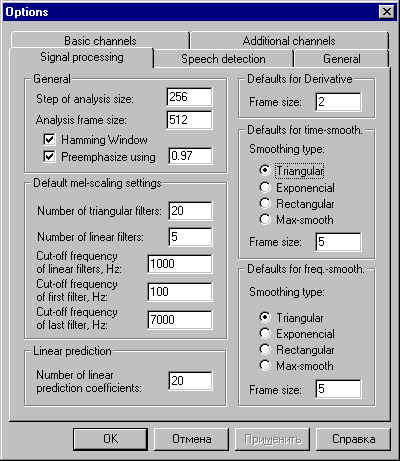 You can change different signal processing
options on this property sheet, such as Step of spectral analysis, Analysis frame size,
number of linear prediction coeffitions etc. and set default values for parameters of
different operations on spectral channels.
You can change different signal processing
options on this property sheet, such as Step of spectral analysis, Analysis frame size,
number of linear prediction coeffitions etc. and set default values for parameters of
different operations on spectral channels.
Speech detection
Spech detection window contains all the speech detection
channels created on Additional channels property sheet. You can urn any channel on
and off independantly. Each speech detector produces "speech detected"
events, that are processed in speech detection processor, the result of which is the event
of the same class. In other words, speech is considered to be detected on some time
interval if and only if all the speech detectors turned on generate the events meaning
that speech is detected by these detectors on the given time interval.
To setup each speech detector, You have to press the Setup...
button.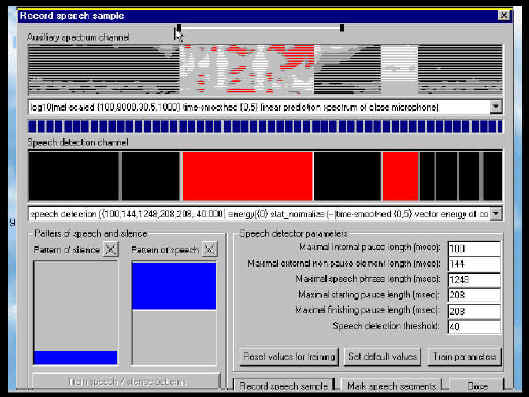
To setup each speech detector. The record speech sample dialog appears. You
have to follow these steps to setup the detector:
1. Select of one of basic or additional channels ian the auxilliary spectral
channels combo box. You will use it to determine wher the speech is.
2. Record a speech sample by pressing the corresponding button and saying one (and
ONLY one) command of the dictionary.
3. Using the left mouse button, mark the speech frames in the recorded speech
(white columns in the lower spectral window, corresponding to the parent channel of this
speech detector). Using right mouse button you can un-mark some frames.
4. Press Train speech-silence patterns button.
5. Move speech boundaries markers on the top of this window to the real
bounaries of speech.
6. Press Reset values for training button.
7. Press Train parameters button. Change the speech detection threshold to 0
(its training does not work so far). Change any other parameters You like.
8. Now You are ready to check the work of speech detector. Go to teh bullet
2. and record the speech sample again.
9. Now press the Mark speech segments button. Segments with speech
will be automatically marked with red and speech boundarieswill be set to appropriate
values automatoically. Yoy can continue the training process from the bullet 4 or
close this dialog.
General options
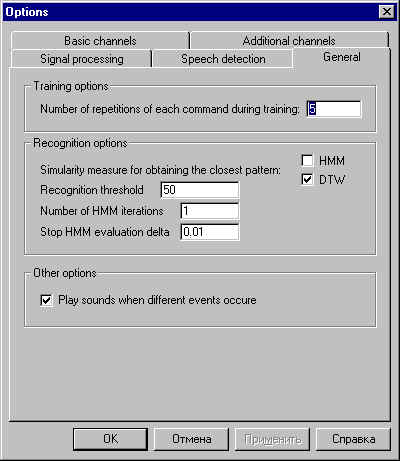 The general options property sheet allows You to change the
following engine parameters: the number of repetitions during training, the recognition
options (what distance metrics to use - HMM or DTW, number of HMM iterations and stop HMM
evaluation delta) and allow You to turn on and off the play sounds option
The general options property sheet allows You to change the
following engine parameters: the number of repetitions during training, the recognition
options (what distance metrics to use - HMM or DTW, number of HMM iterations and stop HMM
evaluation delta) and allow You to turn on and off the play sounds option
 Use "Basic Channels" property sheet to configure
the usage of multi-sensor setup with your sound card(s). Pressing Setup... button
for each channel, you can select the channel type (close microphone, far microphone,
simple photo sensor, complex photo sensor (reserved for future usage) and breath sensor.
Use "Basic Channels" property sheet to configure
the usage of multi-sensor setup with your sound card(s). Pressing Setup... button
for each channel, you can select the channel type (close microphone, far microphone,
simple photo sensor, complex photo sensor (reserved for future usage) and breath sensor. Use "Additional Channels"
property sheet to add special user-defined spectral channels. Pressing the Add
button You can add another channel to the list f additional channels. Remove
button removes one of the selected channels (if it does not have child channels). Remove
All button rmoves all channels from additional channels list. Properties
button opens the Channel Properties dialog box where You can change different parameters
of selected channel. Finally, the Add to Result button allows You
to add this channels to the Resulting spectrum channel components list.
Use "Additional Channels"
property sheet to add special user-defined spectral channels. Pressing the Add
button You can add another channel to the list f additional channels. Remove
button removes one of the selected channels (if it does not have child channels). Remove
All button rmoves all channels from additional channels list. Properties
button opens the Channel Properties dialog box where You can change different parameters
of selected channel. Finally, the Add to Result button allows You
to add this channels to the Resulting spectrum channel components list. You can change different signal processing
options on this property sheet, such as Step of spectral analysis, Analysis frame size,
number of linear prediction coeffitions etc. and set default values for parameters of
different operations on spectral channels.
You can change different signal processing
options on this property sheet, such as Step of spectral analysis, Analysis frame size,
number of linear prediction coeffitions etc. and set default values for parameters of
different operations on spectral channels.
 The general options property sheet allows You to change the
following engine parameters: the number of repetitions during training, the recognition
options (what distance metrics to use - HMM or DTW, number of HMM iterations and stop HMM
evaluation delta) and allow You to turn on and off the play sounds option
The general options property sheet allows You to change the
following engine parameters: the number of repetitions during training, the recognition
options (what distance metrics to use - HMM or DTW, number of HMM iterations and stop HMM
evaluation delta) and allow You to turn on and off the play sounds option